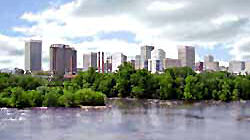|

|
DataShare Metro Richmond
Bridging the Gap ... Data Serving Us All
|
|
|
|
|
|
|
| |
FAQs
- What is the source of the data in the tables on this website?
The source is the U.S. Census Bureau's Summary File 3 for Virginia.
Summary File 3 data are based on a sample of the population who completed the long
form questionnaire for the 2000 census. The sample was used by the Census Bureau
to produce estimates of the characteristics of the larger population. This involves
weighting the data, a statistical procedure that allows accurate estimates to be made
based upon the answers provided by a sample of the population. (See the U.S. Census Bureau
technical documentation at http://www.census.gov/prod/2003pubs/prodpr03-1.pdf.
The technical documentation manual can be downloaded from the Census Bureau's website.
What is the proper way to cite a data table or data used from this website?
What is the best way to acknowledge the source?
The citation should credit both sources, the U.S. Census Bureau and DataShare Metro Richmond.
A proper way to do this is:
U.S. Census Bureau; Census 2000, Summary File 3; recombined by DataShare Metro Richmond;
<http://www.datashare.org> extracted by (name) on (date).
In the parentheses shown above, add your name and the date the data were accessed.
Data extracted or copied from the website should be used in the proper context and with
an understanding of the U.S. Census Bureau's definition of terms. Please review the technical
documentation to be sure the information in the tables is understood. If there is a question
about the information or data after consulting the Census Bureau's documentation, please contact us
- Why are the data presented at the neighborhood level instead of census tracts,
zip codes, or block groups?
In our survey of potential data users, the geographical levels of data most frequently mentioned
were "community" and "neighborhood".
Analysts and practitioners working with small local
communities usually prefer to have access to data at the neighborhood level. While in some cases
neighborhoods correspond to census tracts, in other cases they may comprise territories that do not
coincide with census tract boundaries. This is the case for many Richmond neighborhoods, which often
only comprise parts (block groups) of census tracts. DataShare provides information both at the
neighborhood level and for all block groups comprising each neighborhood.
This site is modeled after the National Neighborhood Indicators Partnership.
Our goal is to make meaningful data accessible to all.
- How did you decide on the neighborhood boundaries?
Neighborhood boundaries were defined by combining block groups that were similar, or homogeneous,
in terms of socioeconomic characteristics.
- How do I know whether the 2000 census data are an accurate reflection of the 2006 reality?
Although 2000 census data might not be an exact reflection of the 2006 reality, they are the most comprehensive
and reliable type of information available at a small geographic level.
- Why do some cells in the neighborhood data tables have an * symbol (asterisk) instead of a number or percent?
An asterisk is displayed when it is not appropriate for DataShare to display a figure at the neighborhood level.
For example, the median household income and median family income are calculated and displayed for Cities and Counties
and the State because they are available in Summary File 3. Neighborhoods, however, are defined by DataShare Metro
Richmond based upon the homogeneity of block groups. Medians are not available for the neighborhoods because a median
cannot be calculated from the medians in Summary File 3. To calculate the median at the neighborhood level, the raw data
for household and family incomes would be needed.<
- When will the neighborhood-level data for the other localities be added to the website?
The data are being compiled by graduate students under faculty supervision in the Urban and Regional Planning
program at Virginia Commonwealth University's L. Douglas Wilder School of Government and Public Affairs.
|
|
|
© 2010 DataShare Metro Richmond Hosted by Virginia Commonwealth University
|